It is still used by the Danish Royal Family. It is located in the Town of Hillerød (circa 1552). This is the town's coat of arms.
Copenhageners have a transit system that is reliable and convenient—even during morning "rush hour". It was the nicest "rush hour" we ever experienced! Digital displays are conveniently located outside the stations to tell you arrival times and any changes... before we go into the station.


(unlike NYC where you must descend all the way to the turnstiles to realize that delays or cancellations happened)...



It was a relief to hear the echo of a train approaching and NOT have to run down the stairs to try and catch it... because if we missed it, another would be there in exactly 4 minutes. It was also a relief to know that all the trains were functioning, which customers can never hope for with NYC's MTA. (Tap the image to read it).

Lewis looked dreamily at Copenhagen's cleanliness and convenience.



Their stations are equipped with eateries; this one has an immaculate 7-11, just as nice as the ones we saw in Japan!

Enjoy this quick video (turn the sound on)...
Transportation across Queen Margrethe's realm is supported by spiffy-sleek trains that Americans are still hoping for. In the image below, a gold crown in the train's logo because trains are operated by the constitutionally-monarchial government.

...which apparently is a tradition on public transport (as seen on the bus logo, below).

Trains have free internet access and Wi-Fi. (Bluetooth technology is named after King Harald Bluetooth, Denmark’s ruler in the 900s, who was the son of King Gorm the Old.)

The train rolled through a forest named Store Dyrehave (Large Animal Park), which was originally a royal deer-hunting park in 1619. In 1680, King Christian V introduced "par force" (royal style) hunting for aristocrats, and his geometric paths and numbered stone posts still remain. Therefore, the park is part of a UNESCO World Heritage Site as a Hunting Landscape of North Zealand. So picturesque!
Here's a quick video of how silently fast the trains are...
As you can see above, Denmark's population smartly supports its sustainable "green" energy efficiency.

It was a fun. The town opted to modernized but keep its historic charm. School children frolicked on a tree stump and in the playground. Pathways gain access to the neighborhood, and many properties have rear gates to the lakefront.







Crossing a curvy bridge, we approached the next gatehouse, even grander than the first, with depictions of mythological creatures. Its square shape is capped by a copper spire, now covered in a greenish verdigris finish. The path was lined with pitched-roof buildings.

Yes, their clean society sweeps the castle pathways.

Another curvy bridge led to the second gatehouse. Through it, we stepped onto to a larger island.

The island held several attractive structures. Built in 1615, its Chancellery was one of Denmark’s finest Renaissance buildings.

As we walked through the archway, the sound of rushing water became audible, as a beautiful fountain came into view. Visibly centered in the archway—filling it like a picture in a frame—the Neptune Fountain is a wondrous arrangement of statues, sprays, cascades, and basins.

A centerpiece of the courtyard, it drew our eyes upward to the wings of the massive castle and the bell-tower, waiting for us on the next island. With no rear walls, that islet gives a full view of the grandiosity. Crossing the third moat finally put us inside it!

The outer walls of the castle touch the water, with no way for an invader to climb up.


The third bridge is guarded by ornately-carved lion statues!
The lower windows on the left-side wing have iron scrollwork that is positively amazing! Neither of us saw such intricacy before. Lewis and I love handcrafted things. True artisans infuse each creation with their energy and love, so it radiates wherever it is. Forced-labor and sweatshops do the opposite, and machineries tend to exclude the "human touch" from their products. Danes have a philosophy that without the "human touch", creations are not impregnated with such folkgeist and are utterly soulless.
Entering an unassuming door gives access to the Chapel, consecrated in 1617 and unhurt by the fire. For centuries, the chapel was used for coronations.

Lewis' video, below, shows how grand the chapel is...
Lewis took these photos. Tap on them to enlarge and see their intricate beauty.
Seen above and below, the pipe organ was built in 1610, and it still plays regularly! The oldest one in Denmark, it has 1,001 wooden pipes.
Seen below, the elongated “gallery” (corridor) spanned the water to connect with a structure named the Audience House. In that era, visitors were not initially permitted into the castle; they stayed on the secondary island in the Audience House and waited for their "audience" with the king or queen.
A road goes through the Audience House to the formal gardens, behind the castle. Most of the castle’s windows enjoy that floral view. In the image below, notice the antique vandalism.
The room was occasionally configured as a Throne Room and a Banquet Hall. That way, its splendidness was appreciated in a variety of ways.
*Related to elegant dining, if you want to see Entertaining tips that I used at my home, please use this link:
As you examine/enlarge the images below, notice the absence of velvet ropes or glass barriers, which American museums use to keep visitors out of rooms and far away from items. That's because Danes and the castle's visitors know how to behave, unlike typically irreverent Americans.

https://halfwindsorfullthrottle.blogspot.com/2021/10/our-trip-to-london-uk-part-4-windsor.html
The royal castle opens at 10am and is a 60-minute train ride from the city. Despite its distance from the city, both the castle and the train were free with our Copenhagen Card. Thanks to our hotel's wonderful proximity to everything, we walked a short distance to the Metro station, which is also a transit hub for the trains. So easy! (At home, 95% of subway stations stupidly do not connect to trains, or each other, even if they are side-by-side Seen below, the red line shows the distance between the busiest stations in Queens... yet the city refuses to build a connection).
Copenhageners have a transit system that is reliable and convenient—even during morning "rush hour". It was the nicest "rush hour" we ever experienced! Digital displays are conveniently located outside the stations to tell you arrival times and any changes... before we go into the station.


(unlike NYC where you must descend all the way to the turnstiles to realize that delays or cancellations happened)...



It was a relief to hear the echo of a train approaching and NOT have to run down the stairs to try and catch it... because if we missed it, another would be there in exactly 4 minutes. It was also a relief to know that all the trains were functioning, which customers can never hope for with NYC's MTA. (Tap the image to read it).

Lewis looked dreamily at Copenhagen's cleanliness and convenience.



Their stations are equipped with eateries; this one has an immaculate 7-11, just as nice as the ones we saw in Japan!

Enjoy this quick video (turn the sound on)...
Transportation across Queen Margrethe's realm is supported by spiffy-sleek trains that Americans are still hoping for. In the image below, a gold crown in the train's logo because trains are operated by the constitutionally-monarchial government.

...which apparently is a tradition on public transport (as seen on the bus logo, below).

Trains have free internet access and Wi-Fi. (Bluetooth technology is named after King Harald Bluetooth, Denmark’s ruler in the 900s, who was the son of King Gorm the Old.)

After trains arrive in the station, the doors close again to keep out the noise and to keep in the air-conditioning. That's nice for passengers. Arriving riders merely press buttons on the doors, and they open. America doesn't have anything like that.
Furthermore, the Danish trains operate with a Germanic punctuality, and they are extremely clean. No litter, smudges, spilled food, or discarded cups. Life as it should be.
As seen above, train cars are equipped with layers of other automated glass doors, to keep the compartments quiet.

If a passenger wants to enter or exit, the motion-censored doors open. Amazing! Notice how CLEAN the trains are: windows, floors, and seats. Click my link to see what New York's pricey commuter trains look like:

If a passenger wants to enter or exit, the motion-censored doors open. Amazing! Notice how CLEAN the trains are: windows, floors, and seats. Click my link to see what New York's pricey commuter trains look like:
https://halfwindsorfullthrottle.blogspot.com/2019/02/metro-north-filth.html
The trains conveniently have trash cans by each exit.

Promptly at 9:22 am, the train's engineer departed the station. The train accelerated smoothly and quietly. A joy to use!
The trains conveniently have trash cans by each exit.

Promptly at 9:22 am, the train's engineer departed the station. The train accelerated smoothly and quietly. A joy to use!
Please notice the digital screens and illuminated Destination Boards above the seats. Smart and helpful.
As we travelled 40 kilometers, Lewis dozed and I watched the scenery. Unlike America—certainly New York—where property along railroad tracks looks like neglected trash dumps, the Danish trackside land is well-manicured and respected because their train system is clean, upstanding, and pride-worthy.
For awhile, the tracks ran parallel to the old Kongevejen
(Royal Road), and the train emerged from Geel's Forest, which is full of steep mountain bike trails and tree-lined byways.
The train rolled through a forest named Store Dyrehave (Large Animal Park), which was originally a royal deer-hunting park in 1619. In 1680, King Christian V introduced "par force" (royal style) hunting for aristocrats, and his geometric paths and numbered stone posts still remain. Therefore, the park is part of a UNESCO World Heritage Site as a Hunting Landscape of North Zealand. So picturesque!
Here's a quick video of how silently fast the trains are...
As you can see above, Denmark's population smartly supports its sustainable "green" energy efficiency.
Arriving at Hillerød Station (the brick building is from 1864), we noticed the smooth transition given to riders who wanted buses or branch-line passenger trains (in yellow).






Walking through the royal town, we followed signposts and opted for the lakeside stroll to the moated castle.

It was a fun. The town opted to modernized but keep its historic charm. School children frolicked on a tree stump and in the playground. Pathways gain access to the neighborhood, and many properties have rear gates to the lakefront.







Looking across the water, we admired the glorious buildings that revealed themselves, as we got closer. Green spires, octagonal towers, turrets, stepped gables, and colorful brickwork… all done is Flemish and Dutch style. It is the largest Renaissance castle in Scandinavia.


We began our quest to explore the castle! Crossing the first moat, we arrived on an islet. Full of stables, carriage houses, circular towers, and barracks, it also constricted access to the castle, against intruders.
Crossing a curvy bridge, we approached the next gatehouse, even grander than the first, with depictions of mythological creatures. Its square shape is capped by a copper spire, now covered in a greenish verdigris finish. The path was lined with pitched-roof buildings.

Yes, their clean society sweeps the castle pathways.

Another curvy bridge led to the second gatehouse. Through it, we stepped onto to a larger island.

The island held several attractive structures. Built in 1615, its Chancellery was one of Denmark’s finest Renaissance buildings.

As we walked through the archway, the sound of rushing water became audible, as a beautiful fountain came into view. Visibly centered in the archway—filling it like a picture in a frame—the Neptune Fountain is a wondrous arrangement of statues, sprays, cascades, and basins.


The outer walls of the castle touch the water, with no way for an invader to climb up.


What's astounding is that most of the castle burned down in 1859 and was rebuilt in the 1860s by Jacob Jacobsen, founder of Carlsberg Brewery in Copenhagen. The kingdom amassed antiques and historic items (300 original paintings were rescued), and the royal family dedicated it as a History Museum. Luckily, craftsman existed in that era; nowadays, it seems a lost art. A foundation established by Jacobsen still funds the castle's operation.
The third bridge is guarded by ornately-carved lion statues!
The lower windows on the left-side wing have iron scrollwork that is positively amazing! Neither of us saw such intricacy before. Lewis and I love handcrafted things. True artisans infuse each creation with their energy and love, so it radiates wherever it is. Forced-labor and sweatshops do the opposite, and machineries tend to exclude the "human touch" from their products. Danes have a philosophy that without the "human touch", creations are not impregnated with such folkgeist and are utterly soulless.
After the Castle Fire, the left wing was one of few parts remaining. That is where we entered, and a docent invited us to begin our tour from the lower level, which is the oldest. As a pair of adventurers, we began our exploration!
The oldest parts of the castle date from the mid-1500s.

Representing 500 years of Danish history, the chambers have a range of stylistic evolution. You can watch the interior designs change—from the Rose Room (seen below)—to, as they call it, a "pompous" 18th-century style. The leather wall coverings, tapestries, wood-carving, plasterwork, stonework, portraits, and metalwork are astounding.

Representing 500 years of Danish history, the chambers have a range of stylistic evolution. You can watch the interior designs change—from the Rose Room (seen below)—to, as they call it, a "pompous" 18th-century style. The leather wall coverings, tapestries, wood-carving, plasterwork, stonework, portraits, and metalwork are astounding.
Entering an unassuming door gives access to the Chapel, consecrated in 1617 and unhurt by the fire. For centuries, the chapel was used for coronations.

Lewis' video, below, shows how grand the chapel is...
Lewis took these photos. Tap on them to enlarge and see their intricate beauty.
Seen above and below, the pipe organ was built in 1610, and it still plays regularly! The oldest one in Denmark, it has 1,001 wooden pipes.
Seen below, the elongated “gallery” (corridor) spanned the water to connect with a structure named the Audience House. In that era, visitors were not initially permitted into the castle; they stayed on the secondary island in the Audience House and waited for their "audience" with the king or queen.
It reminded us of being inside Château de Chenonceau in the Loire Valley of the French Republic (seen below, which is part of a UNESCO World Heritage Site).
The corridor has a stunning ceiling of rich plasterwork!
The lavish passageway has splendid views.
A road goes through the Audience House to the formal gardens, behind the castle. Most of the castle’s windows enjoy that floral view. In the image below, notice the antique vandalism.
Lewis and I entered the upper chamber of the Audience Room, and it is remarkable.
Adorned in late 1600s style—with a gilded wooden chandelier from 1625—the royal reception room overlooked the moat and had a "chair lift" for the king to be hoisted up into the room from. It still works!
With eager footsteps, we returned to explore the castle. Each room was marvelous!
Beyond this amazing doorknob was a grandiose ballroom!
The room was occasionally configured as a Throne Room and a Banquet Hall. That way, its splendidness was appreciated in a variety of ways.
Up close, each coffer is a cornucopia of patterns, knobs, recesses, and carving.

Denmark's royalty still use the ballroom for banqueting, and they use other rooms in the castle for dignitary events.


Denmark's royalty still use the ballroom for banqueting, and they use other rooms in the castle for dignitary events.

The walls are covered in colorful tapestries—also tucked into the window spaces; a sample is seen above (in vibrant colors). We marveled as the costumes changed from the Renaissance through "absolute monarchies" until the current queen.
Enjoy my musical video that swivels through the room...
*Related to elegant dining, if you want to see Entertaining tips that I used at my home, please use this link:
Dazzled by what we saw, we ventured into the next wing of the castle. It featured a lavish bedroom.
Ah yes, there's nothing like life-sized images of shirtless muscled men near the royal bed to get a libido going!
As you examine/enlarge the images below, notice the absence of velvet ropes or glass barriers, which American museums use to keep visitors out of rooms and far away from items. That's because Danes and the castle's visitors know how to behave, unlike typically irreverent Americans.
Seemingly, the entire country is full of accurate clocks. The castle's bell tower chimed 11 o'clock exactly as two antique clocks in the room chimed the time! I was immeasurably impressed with such accuracy!
Things are lovingly well-crafted / well-maintained.
Things are lovingly well-crafted / well-maintained.
Lewis admired the paintings, conjuring storylines for each of them. It made an amusing game, as we toured the succeeding rooms.
Seen below, that painting has "suggestive" tones of eroticism.
*To see the fabulous fortress that King Christian IV created in Norway, please us this link: https://halfwindsorfullthrottle.blogspot.com/2023/08/our-trip-to-oslo-norway-storting.html
Exiting from the castle's courtyard, we crossed the bridges and strolled back to the train station.

I asked Lewis to choose wherever he wanted to have lunch. During our whole trip, Lewis desired Japanese food in Denmark.

As Fate would have it, one was across the street from the local train station, in a historic house. The employees at You Sushi were happy to see us, lit the candle on our table, allowed me to charge my iPhone across the room, and sweetly spoke in Danish, Japanese, and English to all the diners who came in after us. We munched on platters of delectable sushi. The proprietors explained that trains departed every 10 minutes, so there wasn't a rush to catch a train... which was refreshing! (unlike at home)

I asked Lewis to choose wherever he wanted to have lunch. During our whole trip, Lewis desired Japanese food in Denmark.

As Fate would have it, one was across the street from the local train station, in a historic house. The employees at You Sushi were happy to see us, lit the candle on our table, allowed me to charge my iPhone across the room, and sweetly spoke in Danish, Japanese, and English to all the diners who came in after us. We munched on platters of delectable sushi. The proprietors explained that trains departed every 10 minutes, so there wasn't a rush to catch a train... which was refreshing! (unlike at home)

Thanks to Denmark's unpolluted waters and priority for sustainable fishing, the Japanese recipes were perfect. It was a tasty and cozy way to conclude our castle tour.
*If you want to learn about the time we visited an inhabited castle, please click on this link:
Soon, we were back in Copenhagen and took the Metro to King's New Square.

Loving the quick subway ride was therapeutic in itself. The escalators connected to the basement market of an upscale department store named Magasin Du Nord. We went there.

Like Japan, lines on the floor show riders where to wait, to avoid blocking the subway doors... and people obey.

Unlike overpriced NYC...


Loving the quick subway ride was therapeutic in itself. The escalators connected to the basement market of an upscale department store named Magasin Du Nord. We went there.

Like Japan, lines on the floor show riders where to wait, to avoid blocking the subway doors... and people obey.

Unlike overpriced NYC...

Please join us for the final part!























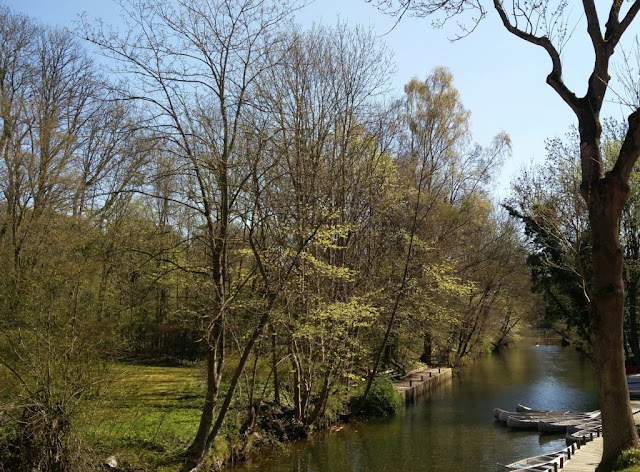


























































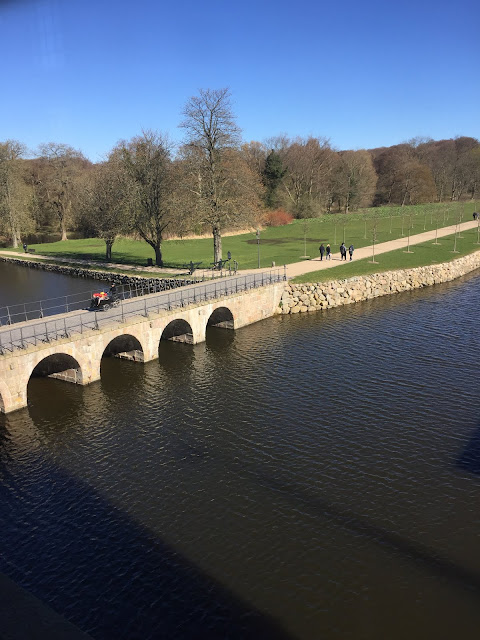


































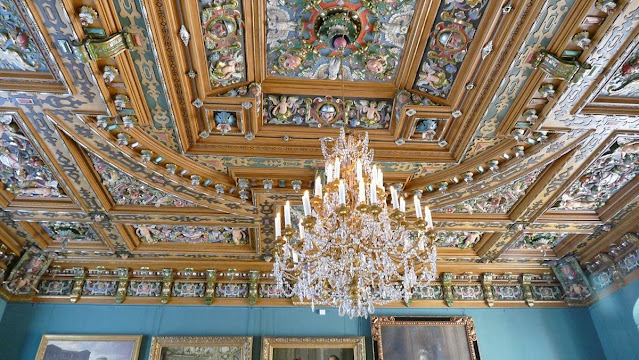


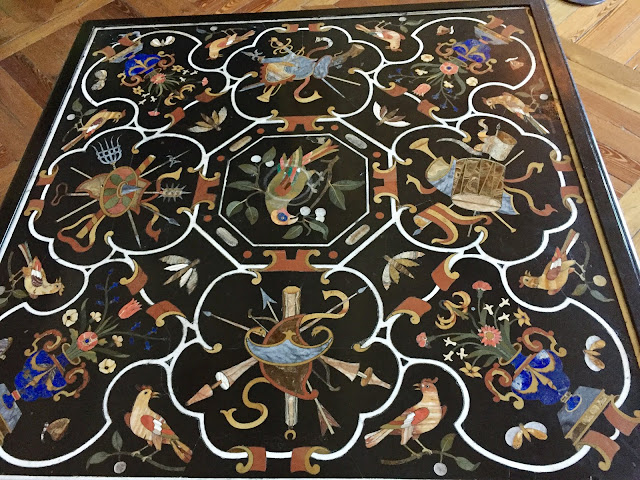













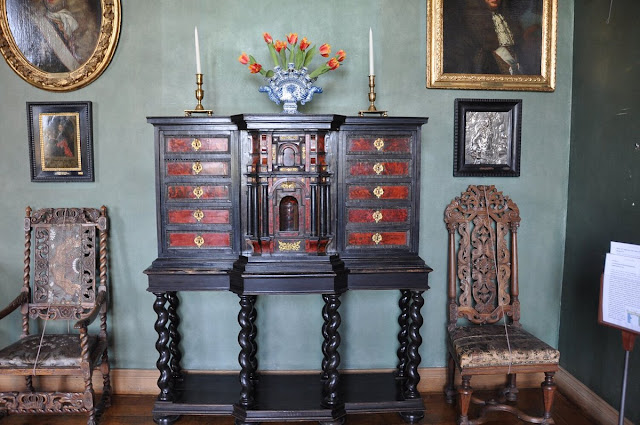













No comments:
Post a Comment
Don't be shy: leave your comments :)